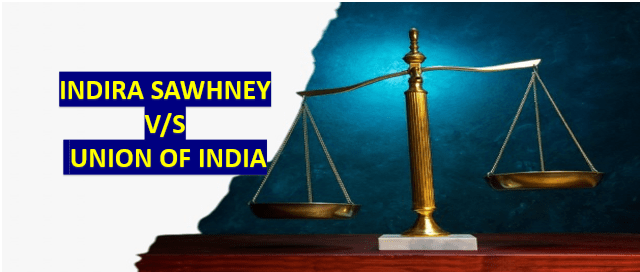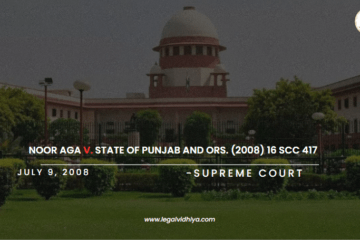
INDIRA SAWHNEY V/S UNION OF INDIA
Citation: AIR 1993 SC 477
Date of Judgment: 16th November 1992
Court: Supreme Court of India
Case Type: Public Interest Litigation Appellant Indira Sawhney
Respondent: Union of India
Bench: M.H. Kania, M.N. Venkatachaliah, S. Ratnavel Pandian, Dr. T.K. Thommen, A.M.
Ahmadi, Kuldip Singh, P.B. Sawant, R.M.
Sahai, B.J. Reddy
| Referred | Articles 14, 15, 16, 46, 340 and 380 of the Indian Constitution, 1950 |
INTRODUCTION
In 1992, the Supreme Court of India handed down a historic decision in the matter of Indira Sawhney v. Union of India, also referred to as the Mandal Commission case. The lawsuit concerned reservations for members of socially and educationally backward classes (SEBCs), also known as Other Backward Classes (OBCs), in government employment and educational institutions. The Indian government created the Mandal Commission, also known as the Second Backward Classes Commission, in 1979 to identify the socially and educationally backward classes and suggest solutions for their improvement. In 1980, the Commission, led by B.P. Mandal turned in its final report, suggesting a 27% reservation for SEBCs in public employment and educational institutions.
The Mandal Commission’s recommendations have been challenged in a number of petitions. The petitioners’ main argument was that the reservation policy violated the equality principle entrenched in the Indian Constitution and would result in reverse discrimination against candidates in the general category. The Supreme Court maintained the constitutionality of SEBC reservations in its November 16, 1992 decision. The court did place some restrictions on the reservation policy, though. It was decided that barring extenuating circumstances, the total number of reservations should not exceed 50% of the available seats. The court also ruled that members of the SEBCs
who are socially and educationally advanced should not be eligible for reservation benefits, a term known as the “creamy layer.”
The case remains an important reference point in discussions and debates surrounding reservation policies and social justice in India. It highlighted the complex and sensitive nature of addressing inequalities and providing opportunities for marginalized communities in a diverse and democratic society.
Keywords: Mandal commission, creamy layer, reservations, caste-based reservations, backward classes, equality, article 14, quota.
FACTS OF THE CASE
1. In accordance with Article 340(2) of the Indian Constitution, the Backward Class Commission, also known as the Kaka Kalelkar Commission, was founded on January 29, 1953. The panel identified 2,399 castes as being socially and economically backward in its report, which was turned in on March 30, 1955. However, the recommendations of the commission were rejected by the government in 1961.
2. On January 1, 1979, the second backward classes commission also known as Mandal Commission was constituted during the Janata Party administration led by Prime Minister Morarji Desai. This commission was presided over by Sir B.P. Mandal was responsible for formulating the standards for ‘socially and economically backward classes (SEBCs) reservation in public employment and posts.
3. In its report, which the Mandal Commission delivered in December 1980, 3,746 castes were classified as being socially and economically backward. It proposed a 27% reservation for OBCs and an additional 10% for openings for socially and economically backward classes (SEBCs).
4. A group of petitioners, led by Indira Sawhney, challenged the implementation of the Mandal Commission’s recommendations. They argued that reservations based solely on caste were against the principles of equality, non-discrimination, and the reservation policy should be based on economic criteria rather than caste.
5. Subsequently, the case was brought before a nine-judge bench of the Supreme Court. The bench sent the administration a notice requesting more information about the standards for
the proposed 27% reserve scheme. The parameters indicated in the office memorandum, however, are said to have been inadequately explained by the Indian government.
ISSUES
1. Is the reservation policy based on caste constitutionally valid or violating Article 16 of the constitution?
2. Should reservations be determined by quantifiable data on social and educational backwardness?
3. What should be the maximum limit or cap on total reservations in government jobs and educational institutions?
4. Should the “creamy layer” within reserved categories be excluded from availing reservations?
CONTENTIONS ON THE SIDE OF THE PETITIONER
It was argued that the policy of reservations based on caste violated the principle of equality enshrined in the Indian Constitution. They contended that the reservation system discriminates against individuals who do not belong to the reserved categories, as it denies them equal opportunities in public employment solely based on their caste or social background.
The petitioner emphasized that the reservations should be based on economic backwardness rather than caste. They argued that poverty and lack of access to opportunities are more relevant factors to consider when addressing social inequality. According to the petitioner, reservations should be provided to individuals who are economically disadvantaged, regardless of their caste.
The petitioner also contended that the exclusion of the “creamy layer” from reservations was not effectively implemented. The “creamy layer” refers to individuals within the reserved categories who are already economically well-off and socially advanced. The petitioner argued that failing to exclude the creamy layer perpetuates privilege and hampers the intended objective of uplifting the marginalized sections of society.
The petitioner raised concerns about the potential adverse impact of caste-based reservations on social harmony and national integration. They argued that the reservation system perpetuates caste divisions and hampers the development of a cohesive society. The petitioner contended that a more inclusive and merit-based approach would foster unity and integration among citizens.
CONTENTIONS ON THE SIDE OF THE RESPONDENT
It was argued that reservations based on caste were necessary to achieve social justice and provide affirmative action to historically disadvantaged and marginalized sections of society. The reservation policy aimed to uplift these sections and provide them with equal opportunities to access education and public employment.
The government contended that reservations were a form of compensatory discrimination aimed at remedying historical injustices inflicted upon certain castes and communities. The reservation policy sought to address the deep-seated caste-based discrimination that had persisted for centuries and provide a level playing field for historically oppressed groups.
The respondent maintained that the reservation policy was constitutionally valid under Article 16(4) of the Indian Constitution. This article allows the state to make provisions for the advancement of socially and educationally backward classes. The government argued that the reservation policy was a legitimate exercise of this constitutional provision to uplift the socially and educationally backward classes.
The government emphasized that reservations in public employment promoted representation and diversity in the workforce. By ensuring adequate representation of historically marginalized communities, the government aimed to create a more inclusive administration that could effectively address the needs and concerns of all sections of society. Reservations were seen as a means to diversify the composition of public institutions and enhance social cohesion.
JUDGMENT
In its judgment, the Supreme Court of India upheld the concept of reservations as a means to achieve social justice and upliftment of marginalized sections of society. However, the court emphasized the importance of maintaining a balance between the interests of the backward classes
and the overall welfare of the nation. The judgment clarified that reservations under Article 16(4) should not exceed the ceiling limit of 50%. The court held that exceeding this limit would undermine the principles of equality and equal opportunity, and could lead to reverse discrimination against other deserving candidates.
The court recognized that backwardness cannot be solely determined based on economic criteria and that social and educational backwardness are equally important considerations. It recommended the establishment of the National Commission for Backward Classes to identify and categorize backward classes and emphasized the need for periodic revision of the list of backward classes to ensure that reservations reach the deserving sections of society.
The court held that the creamy layer should be excluded from the benefits of reservations. It emphasized that reservations should be targeted towards the truly disadvantaged sections of society who have historically faced social discrimination and lack access to equal opportunities. Including the creamy layer within the reservations would defeat the purpose of affirmative action and may perpetuate inequalities by providing benefits to those who are already socially and economically privileged.
This is written by Tripura Sriya Pilladi a student of ICFAI Law School, Hyderabad, 6th semester, an Intern under Legal Vidhya.




0 Comments